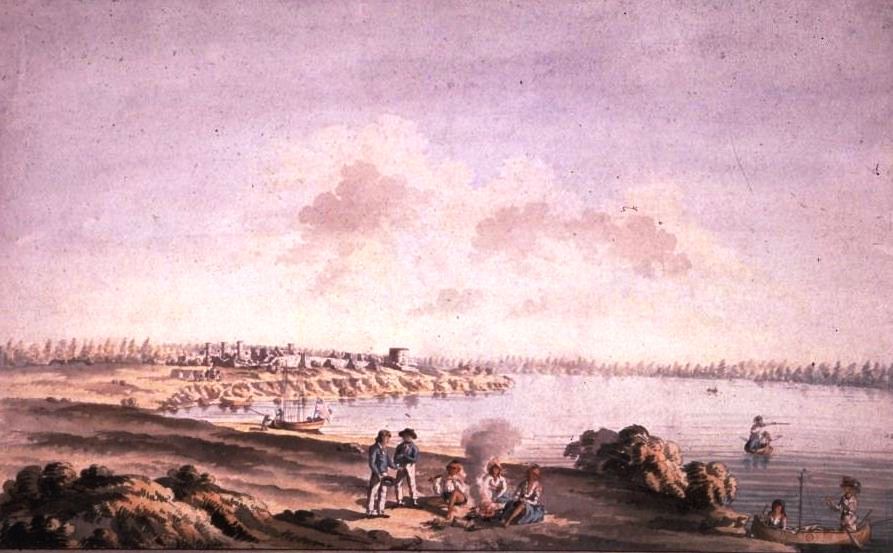I have been putting my mind to the question of who was the first Loyalist brewer in what is now Ontario. Not the first brewer but the first Loyalist brewer. Which means there is a starting line that is fairly identifiable, the end of the American Revolution. The image above is by James Peachey, a war artist, of some of the first Loyalists settling in at Kingston next to the ruins of a French outpost last populated from 1673 to 1758 or so. The image is from June 1783 as the first Royalist Americans trickle in from the south, from places like Albany, NY. Their tents in the back by the ruins are just about where this place sits now.
The usual story is that the first brewer in Ontario was Forsythe at Kingston in 1793 or Finkle at Bath around 1786 or so at his tavern, the first between Kingston and what is now Toronto. Based on the records. Which is what is great about records and what sucks about them. See, in that picture above I see he beginnings of a wave, the fist few of a lot of displaced farmers and successful towns folk. Not a lot of them are going to be very much against having an ale. And not very many of them are going to have much to do at the moment, being displaced refugees given three years of supplies. It does not make much sense to me that such capable folk are going to wait years for investment in a fixed brewery or the opening of a tavern to get their beer. I have been looking for something that will back up my suspicions. Like this bit about Joel Stone, a Loyalist from Connecticut who in about 1787…
made the journey together up the St. Lawrence to the ramshackle refugee camp of New Johnstown (now Cornwall, Ontario). Ever reliant on his family, his half-brother Stephen came up to assist Joel. Along with him came eleven other men from Litchfield, all eager to take up lands in the new province. Stone once had high hopes in this new land, even petitioning Sir Guy Carleton to make him “Deputy Surveyor General.” Stone would receive no such government office upon arriving in Canada. Instead he wrote to his father, “I have begun making malt brewing beer and distilling spirituous liquors from wheat, barley, rye etc…”
See, one thing I see over and over is how easy beer is to make with the basic ingredients and a basic sense of the technique. And if I can do it what in God’s name would keep someone in the 1780s from doing it, too? Nothing. We see this today all around us. A surge of new and in progress breweries popping up, of many degrees of quality from any sort of brewer. A bucket or two of malt, heat, water and some herbs from the bushes and – voila – you’ve got your beer.
It’s the resilience of beer and the will to make it and drink it that impresses. Whether setting aside a portion of your supply of seed in the 1780s or, today, scraping enough to get the first growler out the door, there is a will to brew. Doesn’t mean you’ll last, be remembered or even be any good. Beer doesn’t really care. It just wants to be made, that’s all.


[Original comments…]
David – August 7, 2013 8:45 AM
http://www.foodwithlegs.com
There were enough British soldiers and sailors stationed in Upper Canada during the Revolutionary War that I’d be surprised if they were all drinking imported beer. I bet that’s the place to look: from where were the garrisons at places like Kingston and Newark (now Niagara-on-the-Lake) buying their beer.
Alan – August 7, 2013 10:33 AM
Any British soldiers in this area would not have been in what became Upper Canada from 1791 to 1840. The would have been at Montreal, fewer on Carleton Island NY, Niagara NY or maybe but unlikely Oswego. That would not have been a safe spot with the Revolutionaries holding Stanwix in what is now Rome, NY.
Alan – August 7, 2013 10:45 AM
Carleton Island life was a bit grim according to the story on a recent dig under that link. But maybe there was something being brewed at Niagara. Generally they were serviced by the more efficient casks of rum as Cartwright shipped.
Alan – August 7, 2013 11:26 AM
Bingo! Beer at Carleton Island during the Revolution, David. And as the island did not legally transfer to the US until 1794 and was not finally abandoned until the War of 1812, it should be part of the history of Ontario beer and brewing.
Steve Gates – August 9, 2013 1:15 AM
I believe Cartwright’s business partner, Robert Hamilton was actually stationed on the island before their partnership, The merchant’s inventories listed in the reference includes rum by the hundreds of gallons but an absence of beer, could the tap be used for the distribution of rum? These guys and their rum, there’s some hard bark on these fellas. The reference concerning Joel Stone is very interesting, another hard fella, as was his second wife, who took a musket ball in the war of 1812 and lived to tell about it. Have you done any research on a brewer and distiller named Trumpour, a Loyalist from Adolfustown who brewed very early, basically as soon as he got of the boat at Hay Bay .Priority of work for these guys ;build shelter, clear land, till land, brew beer. Nobody is helping you raise a barn without beer.